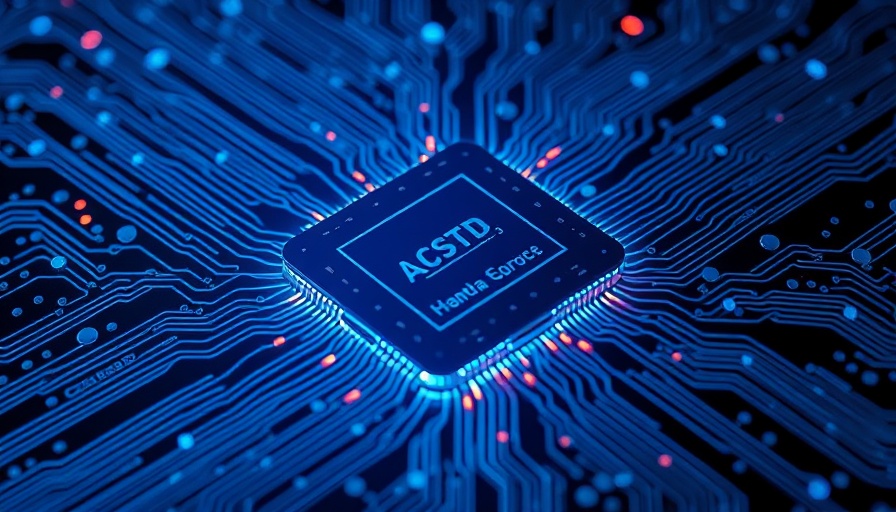
The Evolving Landscape of U.S. Semiconductor Industry in 2025
2025 is shaping up to be a critical year for the U.S. semiconductor industry, a sector pivotal to the nation's technological advancement and economic stability. As competition intensifies globally, particularly in the AI arena, understanding the trajectory of this industry is essential for tech enthusiasts and professionals alike.
Key Political Shifts Impacting the Semiconductor Sector
Throughout 2025, the U.S. semiconductor market has already witnessed significant political maneuvers influencing its landscape. For instance, the Biden administration's proposed AI chip export regulations aim to address security concerns, specifically regarding high-tech chips potentially reaching hostile nations such as China. This is particularly visible with the restrictions surrounding Nvidia's H20 AI chip, which faces new licensing requirements—an endeavor aimed at maintaining U.S. competitiveness and technological superiority.
Conversely, former President Trump's recent reversal of these export restrictions adds a layer of unpredictability. Just as the new regulations were set to take effect, Trump's administration decided to pursue a different direction, focusing on a fresh framework for AI diffusion. This swirling political climate can leave stakeholders uncertain, illustrating the complex interdependencies of technology with governance.
Corporate Restructuring Amid Industry Change
The semiconductor giants are not immune to the pressures of the evolving market; Intel, under the guidance of new CEO Lip-Bu Tan, announced major layoffs, affecting over 21,000 employees. This decision reflects a strategic move to streamline operations and refocus the company's resources toward innovation—an imperative for survival and growth in an aggressive tech sector.
These significant layoffs indicate that even established firms must pivot quickly, demonstrating agility to capitalize on new business opportunities while navigating legislative challenges. Companies such as Nvidia are also adapting their strategies, showcasing resilience as they attempt to navigate their way through complex trade landscapes.
The Role of Major Players in Tech Innovation
Nvidia continues to dominate headlines with its innovative AI technology. As persistent concerns emerge about U.S. chip exports, the company is banking on strategic partnerships and dialogues with governmental bodies to mitigate risks. Nvidia's CEO, Jensen Huang, was recently spotted at Trump’s Mar-a-Lago, suggesting the importance of alignment and dialogue between tech leaders and government officials.
This relationship underscores a crucial dynamic: the influence of corporate leaders on public policy and the necessity for these leaders to play proactive roles in shaping the future of technology regulations. As the AI race heats up, collaboration between tech firms and the government may very well determine the trajectory of global technology leadership.
Looking Forward: The Future of the Semiconductor Market
As we project into the future, several trends are expected to shape the semiconductor industry through 2025 and beyond. Continued investment in AI technologies will likely remain a focal point, with key players driving innovations in chip design and manufacturing efficiency. Additionally, as regional powers like China ramp up their tech capabilities, vigilance among U.S. companies will be pivotal.
Moreover, we can expect potential shifts in trade policies that could either facilitate or hinder U.S. semiconductor exports. The interconnections between industry performance, government policy, and international relations paint a complex landscape where adaptability will be crucial.
What This Means for Consumers and the Tech Enthusiast
For the average consumer and tech enthusiast, understanding these dynamics within the semiconductor industry is vital. As innovation in AI and technology accelerates, the implications of supply chain disruptions, new regulations, and corporate realignments will resonate across diverse sectors, affecting everything from pricing to availability of cutting-edge devices.
Moreover, being informed about the trends in semiconductor advancements is not just beneficial for industry professionals but for every consumer navigating a market increasingly driven by technology. The unfolding events in 2025 provide a lens into the challenges and opportunities that the tech landscape will face in the years ahead.
Conclusion and Future Considerations
The semiconductor industry is at a crossroads in 2025. As it grapples with political shifts, corporate restructuring, and competitive pressures, the implications of these changes will undoubtedly extend beyond the boardroom into everyday life. Keeping abreast of these trends is key for all who engage with technology in today's digital age.
 Add Row
Add Row  Add
Add 



Write A Comment